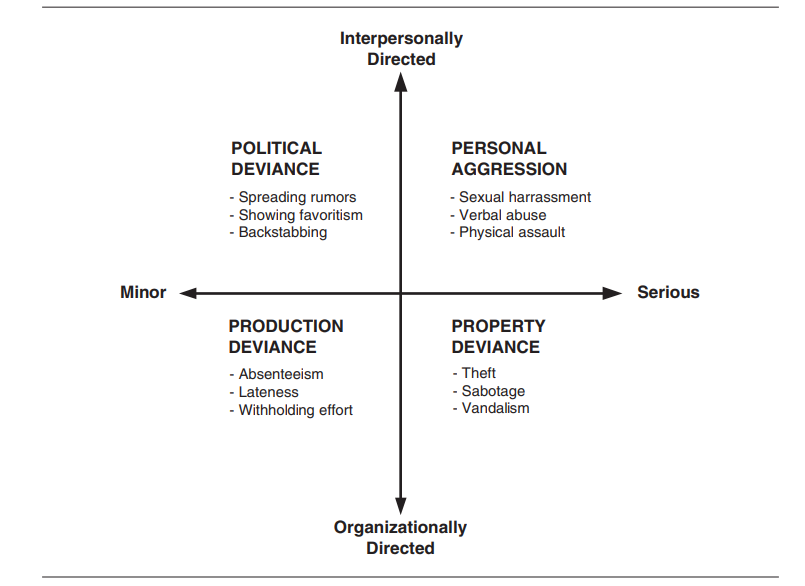Although corruption pervades every sector of our economy. A major problem is counterproductive work behaviours. There has been extensive research on emotions and different studies have established the importance of emotions and their subsequent impact on employee and organizational performance. Thus emotions play an important role in determining CWB in the originations thus, Spector and Fox (2002) consider negative emotions as a potential determinant of CWB. The negative emotions like hopelessness, frustration and disgust are generally referred to as cynicism (Anderson & Bateman, 1997) which can result in non productive behaviors (Storm & Spector, 1987). Mount, Ilies & Jhonson (2006) consider personality as a determinant of CWB. It is important to note that though external factors contribute towards determining CWB, internal factors do play a role in this regard , thus type of personality also contribute towards explaining the phenomena of CWB.

Counterproductive work behaviour refers to actions by employees that go against the goals and aims of their employer. CWB is not necessarily malicious but it is always conscious – it doesn’t include accidental or unconscious behaviours or incidents. The driving forces behind counterproductive work behaviour can be very broad and include environmental reasons, lack of training, employee personality and life changes and external factors.
Counterproductive work behaviours include: abusive behaviour, physical and verbal aggression, making intentionate improper work, sabotage, theft, absenteeism, misuse of information , delays , unsafe behaviour, poor attendance, and poor quality work. This includes destruction and misuse of organizational property and destruction acts directed toward organizations rather than people (although people are often indirect targets) doing work incorrectly, or failing to notify superiors about mistakes and work problems (e.g., a machine malfunction), and withdrawal (e.g., calling in sick when not ill). etc.. Research on such topics has proliferated in recent years in recognition of the staggering financial (Robinson, 2008), personal (Schat & Kelloway, 2005) and organizational costs associated with counterproductive behaviour ( Rogers & Kelloway, 1997).These include economical cost (loss of productivity due to delay at the workplace, theft or sabotage) or psychological cost (withdrawal or low job satisfaction- for those who are targets of counterproductive interpersonal behaviours or high stress and uncertainty – for those who perceive such behaviours) (Varda and Weitz 2004).


Typologies are used to identify and classify CWB in the workforce.
One typology, by Robinson and Bennett (1995), uses the following four categories:
Production deviance e.g. tardiness or goldbricking
Property deviance e.g. theft or sabotage of equipment
Political deviance e.g. gossiping or favouritism
Personal aggression e.g. sexual harassment or workplace bullying
CWBs do not include unethical or illegal behaviours that contribute to an organisation’s goals, such as an investment banker using insider trading to increase the bank’s profit – this would form part of unethical pro-organisational behaviours (UPBs).
Perceptions of fairness in the workplace have been found to be strong drivers of counterproductive work behaviours – if a supervisor is perceived to have been unfair then the employee may in future ‘forget’ to flag up a potential issue to the supervisor so that the supervisor gets in trouble if the issue becomes severe.
Examples of Counterproductive Work Behaviors
CWB examples are broad and range from insulting a colleague to damaging company property. They can be grouped into four categories based on these characteristics:
1. Tardiness and Absenteeism
Every workplace suffers from late or absent employees to some degree, which is why many implement absence-control policies to address the issue. Rather than forcing management or team leaders to assess each case on an individual basis, businesses should consider creating a formal set of rules to guide decisions on this subject. In many cases, these two factors are also linked to overall workplace satisfaction, scheduling and other issues outside of an employee’s control.
2. Bullying and Harassment
Public awareness of the profound effects of workplace bullying and harassment has increased in recent years, but these issues are still far from resolved. Malicious or unwanted interactions between employees can make workers uncomfortable, isolated and far less productive. Awareness of these issues allows employers to set up rules and systems to protect their personnel from negative social interaction in the workplace.
3. Overworking and Late Nights
Whether it’s routinely keeping employees late or encouraging them to take their work mentality home each evening, overclocking employees can have a devastating effect on their productivity. In fact, the lack of sufficient sleep and rest from professional responsibilities is directly linked to an increase in workplace accidents and lower quality results, according to the Society for Industrial and Organizational Psychology. Employees shouldn’t feel pressure to immediately respond to emails during off-hours or be obligated to commit to late nights on a regular basis.
4. Digital Loafing
Loafing on the job has been an issue for employers for about as long as there have been jobs, but modern digital technology has opened a whole new realm of time-wasting opportunities. Social media is a common culprit, especially in office environments where workers spend a lot of time on computers. Businesses struggle to find a balance between policing how employees spend time and giving them free rein to fritter away the day on idle activity. Clear policies and the ability to enforce them require some level of supervision, but excessive oversight can also damage loyalty, morale, and retention.
5. Breakdowns in Communication
There are several common sources of communication breakdowns within an organization and they can be surprisingly counterproductive. Employees may hesitate to ask questions or confirm responsibilities for fear of looking silly or being reprimanded for lack of attentiveness. Poor communication between teams and departments can also put projects behind schedule and result in duplicated work, which is nothing but a waste of time and resources.
Achieving a completely efficient workplace is an idealistic dream for any company leader, but it’s also nothing more than an ideal. There will always be room for improvement in any organization, which is why leaders should always prioritize the issues that most impact their specific organization. Identifying and addressing common sources of counterproductive behavior won’t solve everything, but it can make a massive difference in the overall quality and quantity of worker output.
6. Production deviance
Any action through which an employee sabotages their own productivity is considered production deviance. For example, an employee will be pretending to work while neglecting their tasks. This will result in an increasing number of tasks and less and less time to do them. Such type of behavior is also called goldbricking – pretending to create something valuable while doing inefficient, non-work activities. Surfing the web instead of dealing with work responsibilities is a typical example of production deviance in the internet age.
7. Property deviance
This is a more severe type of CWB, where employees either damage tangible assets of a company or acquire them without authorization. It includes sabotage, theft, intentional errors, and financial malversations, which require additional spending on repairs and equipment replacements. Further damage comes in the form of replacing the employees conducting unwanted activities and finding new ones, which is costly.
8. Political deviance
This is usually caused when some employees feel entitled or exploited, so they start misbehaving in specific ways. Political deviance includes gossiping and showing favoritism, resulting in an unproductive work environment. These behaviors do not seem serious since they are not explicitly against workplace policies but are incredibly unhealthy. They typically decrease happiness in the workplace and ultimately cause a high turnover rate.
9. Personal aggression
This type of behavior is in direct conflict with workplace policies. It includes verbal abuse, physical abuse and sexual harassment, which have a strong negative impact on the total output of the organization. It can quickly spread to the entire company if the action against such toxic behavior is not taken immediately. Nobody wants to have a hostile work environment where their workers feel unsafe.

“A Typology of Workplace Deviance” by Thomas B. Lawrence and Sandra L. Robinson, Source
Why Is Counterproductive Work Behavior Occurring in the Workplace?
The driving forces behind counterproductive work vary from personal ones such as employee personality, personal life changes to more broad ones, lack of management control, weak sanctions for violations of rules, lack of training, and organizational changes such as downsizing.
Research shows that they have one element in common – low levels of organizational justice in the workplace. It refers to the perception of workplace fairness by people working in an organization, which influences their performance and motivation levels.
Employees who feel unfairly treated will be more likely to engage in deviant behavior that damages the company or the people working there as an end goal. This, naturally, affects productivity.
Addressing counterproductive work behavior (CWB) is more than a matter of saving a bit of money. For some employers, improving overall worker productivity plays a decisive role in establishing competitive advantage and ensuring long-term success. While it’s easy to blame the internet, smartphones and other marvels of modern technology for a distracted workforce, there are actually many types of counterproductive behavior that can distract employees and detract from their results.
Strategies used to manage counterproductive work behaviours (CWB)
Strategies used to manage counterproductive work behaviours (CWB) in the workplace are common at the recruitment stage, where companies use procedures like integrity screening and personality screening to identify individuals who may have a history of propensity to CWBs. Among incumbents, one of the biggest ways to reduce the incidence of CWBs in the workplace is by enhancing organisational justice and balancing perceptions of fairness.
Managers can significantly affect the feelings and behaviors of their employees, so they have a big responsibility in reducing counterproductive work behavior.
1. Hire carefully
The best way to deal with CWB is prevention. You should set clear hiring policies, to begin with. One good piece of advice is to include character questions in interviews to see if the candidates’ answers align with the values of your organization. This is the first step in eliminating job applicants who voluntarily engage in undesirable behaviors.
2. Communicate clearly
The hiring process is not a hundred percent certain method of getting the right people for your company, so counterproductive work behavior might still occur. If they do, the best you can do is address them as soon as possible and be clear about the consequences of such behavior.
Handling misconduct can be challenging, especially if it is not serious. This is the case with being late or overhearing gossip in your team, which by itself does not cause a lot of harm, but with repetition, can significantly reduce productivity in the workplace.
Remember that you should carefully approach employees who commit more minor breaches since there might be genuine reasons for their behavior. At the same time, be clear and assertive in your communication, so they are aware that you will not tolerate repeated actions that are misaligned with company policies.
3. Take immediate action
For more extreme cases of CWBs, urgent action is a necessity. That is the only way you will manage to protect your other employees and the company itself. For example, if one of your employees sexually harasses others, you have to act immediately and remove them from the company and the rest of the team.
Besides protecting your employees and preventing further damage, this action will send a strong message about what kind of behavior is not acceptable in the workplace.
Final Remarks
A completely efficient workplace is a goal that is practically impossible to reach since there will always be room for improvement in many areas. Still, don’t be discouraged. You should know that taking even small steps towards creating a better workplace creates a tremendous difference in the overall quality of the work output and environment.
Counterproductive behavior in the workplace is not uncommon, but it can be recognized, minimized, and prevented in the future so you can boost your employee morale and protect company resources.
Credit
